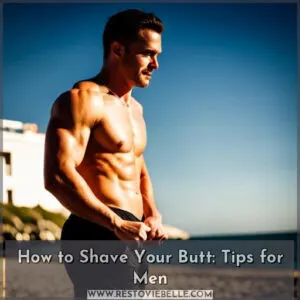This site is supported by our readers. We may earn a commission, at no cost to you, if you purchase through links.
 The choice to shave with or against the grain can make all the difference in your shaving experience. Shaving with the grain won’t irritate you, but it may not be as close.
The choice to shave with or against the grain can make all the difference in your shaving experience. Shaving with the grain won’t irritate you, but it may not be as close.
On the other extreme, shaving against the grain gives more smoothness but has an increased ingrown risk. Mastering this technique will require skill, knowledge of how your hair is growing, and the right tools.
This will help you reach a smooth and comfortable shave, as it is explained what each method can profit from and where there may be risks.
Table Of Contents
- Key Takeaways
- Understanding Hair Growth Patterns
- Shaving With the Grain: Pros and Cons
- Shaving Against the Grain: Benefits and Risks
- Techniques for Different Body Areas
- Best Practices for a Smooth Shave
- Alternative Shaving Methods
- Frequently Asked Questions (FAQs)
- Is it better to shave with the grain or against it?
- Should you shave with or against the grain pubes?
- Is it okay to shave upwards?
- What direction should you shave?
- How can I reduce razor burn effectively?
- Are there specific razors for sensitive skin?
- Whats the best aftershave for irritation?
- How often should I replace razor blades?
- Can shaving affect hair growth rate?
- Conclusion
Key Takeaways
- Shaving with the grain is a smooth operator, reducing irritation but leaving a little stubble behind.
- Shaving against the grain is the daring adventurer, giving you a closer shave but watch out for ingrown hairs.
- Cross-grain shaving is the happy medium, offering a balance of closeness and comfort.
- The multi-pass technique is the ultimate daredevil, giving you the smoothest shave but tread carefully to avoid irritation.
Understanding Hair Growth Patterns
First of all, to be able to shave well, you’ll have to turn into a kind of beard cartographer. Begin by charting the course your facial hair tends to grow in most of the time. Run your hand over your stubble to feel where it grows. What you’ll see is that it doesn’t grow uniformly on your face; actually, it swirls around, changes direction, and sometimes even grows in opposing ways.
Be more observant of the contours of your face and how they make your hair grow. Typically, your jawline, chin, or neck will have different patterns. Make sure you remember whether it’s thick or thin at certain places and how sensitive your skin is.
Understanding these patterns is the key to deciding whether to shave with or against the grain. It’s the basis of how you shave. Take time to study your stubble length and how it affects your shave.
Shaving With the Grain: Pros and Cons
When you shave with the grain, you’ll experience less skin irritation and reduce the risk of razor burn. However, this method may not provide as close a shave as going against the grain, leaving you with a slightly rougher feel and potentially more visible stubble.
Reduced Irritation
Now that you understand hair growth patterns, let’s explore the benefits of shaving with the grain. One major advantage is reduced irritation. By following the natural direction of hair growth, you’ll minimize skin irritation and razor burn. Here are four key ways to further reduce irritation:
- Apply gentle pressure while shaving
- Use a pre-shave lotion or warm compress
- Exfoliate with a scrub before shaving
- Choose the right razor for your skin type
These steps, combined with proper post-shave care, will help you achieve a smoother, more comfortable shave.
Less Close Shave
While shaving with the grain reduces irritation, you’ll trade off a close shave. Your skin will thank you, but you might need to shave more frequently.
This method’s impact on skin sensitivity is minimal, helping you avoid irritation and ingrown hairs.
If you’re looking for alternative methods, consider using a quality shave gel or cream.
Shaving Against the Grain: Benefits and Risks
Shaving against the grain can give you a closer shave, but it comes with a higher risk of ingrown hairs. You’ll need to weigh the benefits of a smoother result against the potential for skin irritation and bumps when deciding whether to shave against the grain.
Closer Shave
Shaving against the grain can give you that ultra-close shave you’re after. You’ll feel smoother and enjoy less frequent shaving sessions.
The three-pass method, incorporating against-the-grain strokes, often yields the closest results.
But beware – this technique isn’t for everyone. Sensitive skin might rebel with irritation.
If you’re up for the challenge, pair your against-the-grain shave with a soothing aftershave balm to calm your skin and lock in that smooth feeling.
Increased Risk of Ingrown Hairs
Shaving against the grain can increase the risk of ingrown hairs. This happens when hairs curl back into the skin instead of growing outward, leading to:
- Inflammation and redness
- Folliculitis, where hair follicles become infected
- Scarring from repeated irritation
- Skin damage and infection
- Razor burn and strawberry legs
To mitigate these issues, use sharp razor blades and follow proper post-shave care.
Techniques for Different Body Areas
What matters most, however, is the manner used in shaving different body parts from the face down to the legs and pubic area. Knowing the direction of hair growth and using the correct method are essential in achieving that smooth shave with minimal irritation.
Facial Hair
Exfoliate your skin well before shaving facial hair. Apply pre-shave oil on thicker hairs and shaving gels for protection. Always shave with the grain first; this causes less irritation, then against for a closer shave. Then, finish it off with the three-pass method and wet shaving.
Legs and Arms
When shaving legs and arms, hydrate well, use quality shaving cream, and consider your skin sensitivity. Start by shaving with the grain to reduce irritation. For a closer shave, use lighter, controlled strokes against the grain. Remember, post-shave care is essential to avoid ingrown hairs.
Pubic Area
When shaving the pubic area, focus on minimizing razor burn and skin irritation. Use a sharp razor and shave in the direction of hair growth to prevent ingrown hairs. Both males and females with sensitive skin can benefit from these techniques:
- Trim first
- Hydrate well
- Use gentle strokes
Best Practices for a Smooth Shave
First, get your skin ready for this nice shave, and second, select the appropriate razor for your needs. With the shave done, consummate the ritual by taking good care of your skin with proper post-shave treatments to calm and moisturize it.
Proper Skin Preparation
Master a smooth shave with proper preparation. Begin by hydrating the skin using warm water, followed by pre-shave exfoliation to remove dead skin cells, and finish with a good shaving gel or shaving cream to soften the hairs and bond with them for less friction. This will help you reduce irritation and feel more comfortable when shaving.
Choosing the Right Razor
The right razor makes for a smooth shave. Some features to look out for in razors include sharpness, weight, design, and feel or grip. A well-balanced razor with a good design and a comfortable feel at the grip will help you not risk nicks. Consider the type of shaving blade for precision cutting to enhance your shaving experience.
Post-Shave Care
After you’ve chosen the right razor, focus on post-shave care. Rinse with cold water to close pores, pat dry with a soft towel, then apply moisturizing aftershave, soothing balms, calming serums, hydrating gels, or protective lotions to soothe, hydrate, and nourish your skin.
Alternative Shaving Methods
Looking to take your shaving game to the next level? Consider exploring cross-grain shaving and the multi-pass technique – two alternative methods that can help you achieve an exceptionally close and smooth shave.
Cross-Grain Shaving
Cross-grain shaving offers a balance between closeness and skin comfort. By shaving perpendicular to hair growth, you reduce stubble effectively without excessive irritation. Here’s how to do it:
- Prep Skin: Hydrate and apply a quality shave gel.
- Use a Sharp Razor: Dull blades increase skin irritation.
- Light Strokes: Shave gently across the grain to minimize risks.
This technique offers smooth results with less skin irritation.
Multi-Pass Technique
Moving from cross-grain shaving, the multi-pass technique allows for a super close shave. This method involves shaving with the grain first, then across, and finally against. Each pass reduces stubble without irritating sensitive skin.
| Pass | Direction | Benefits | Considerations |
|---|---|---|---|
| 1 | With the grain | Minimizes irritation | Leaves some stubble |
| 2 | Across the grain | Closer shave | Requires careful technique |
| 3 | Against the grain | Smoothest result | Risk of post-shave irritation |
Frequently Asked Questions (FAQs)
Is it better to shave with the grain or against it?
Shaving with the grain minimizes irritation, making it ideal for sensitive skin, but doesn’t achieve the closest shave. Shaving against the grain provides a closer shave but increases the risk of irritation and ingrown hairs.
Should you shave with or against the grain pubes?
For pubic hair, shave with the grain to prevent irritation and razor burn. If you desire a closer shave, shave against the grain carefully, using a sharp razor and plenty of shaving gel for smooth results.
Is it okay to shave upwards?
Yes, but be careful. While shaving upward—and against the hair’s direction—will bring about a closer shave, this shaving method has accompanying risks of irritation and razor burn. It’s essential to have a sharp razor and to use proper technique.
What direction should you shave?
You should shave with the grain to minimize irritation and reduce the risk of ingrown hairs. If you need a closer shave, try shaving across the grain. Save against the grain for tougher, durable skin.
How can I reduce razor burn effectively?
Hydrate your skin for at least 3 minutes before shaving to reduce razor burn by up to 70%. Always use a sharp razor, apply quality shave gel, and follow up with an aftershave balm or moisturizer.
Are there specific razors for sensitive skin?
Yes, there are specific razors for sensitive skin. Opt for razors with multiple blades for a gentler shave, lubricating strips for added comfort, and flexible heads that adapt to facial contours, reducing irritation.
Whats the best aftershave for irritation?
For irritation, use an aftershave balm with aloe vera or witch hazel. These ingredients soothe, hydrate, and reduce redness, giving you a comfortable post-shave experience without the sting of traditional alcohol-based aftershaves.
How often should I replace razor blades?
Replace your razor blades after every 5 to 7 shaves to maintain a close, smooth shave and minimize issues like irritation, razor burn, and skin infections (Source).
Can shaving affect hair growth rate?
Shaving doesn’t affect hair growth rate. It might seem like hair grows back thicker or faster, but this illusion is due to the blunt tip created by shaving, not an actual change in growth speed or density.
Conclusion
Smooth shaves are almost an art form; they require the right touch and knowledge. Knowing if you’re shaving with or against the grain makes a difference.
Shaving with the grain is less likely to irritate but won’t be as close. On the other hand, shaving against the grain offers a closer shave but increases the risks of ingrown hairs.
Apply proper skin preparation methods using the right razor and practice post-shave care. Consider alternate ways, like cross-grain shaving. This way, your technique will pay off with smooth and enjoyable results.










